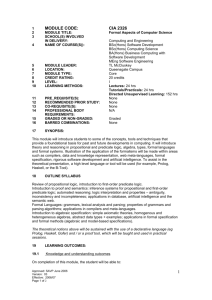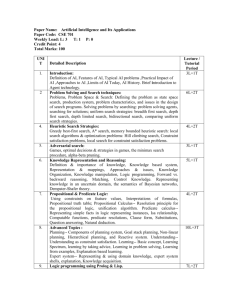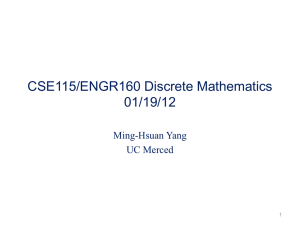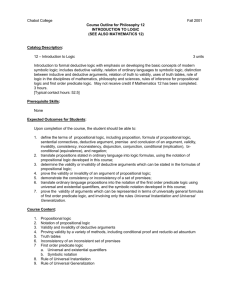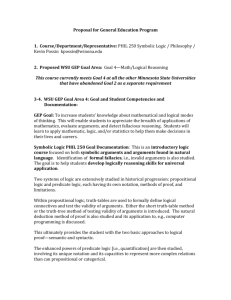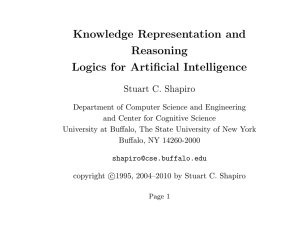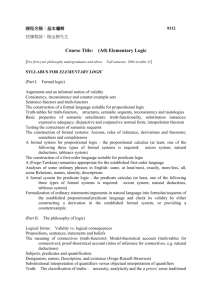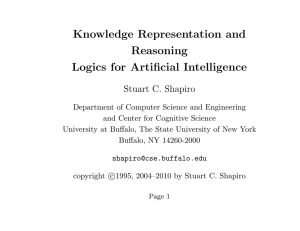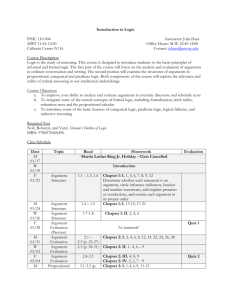Math. 112
advertisement
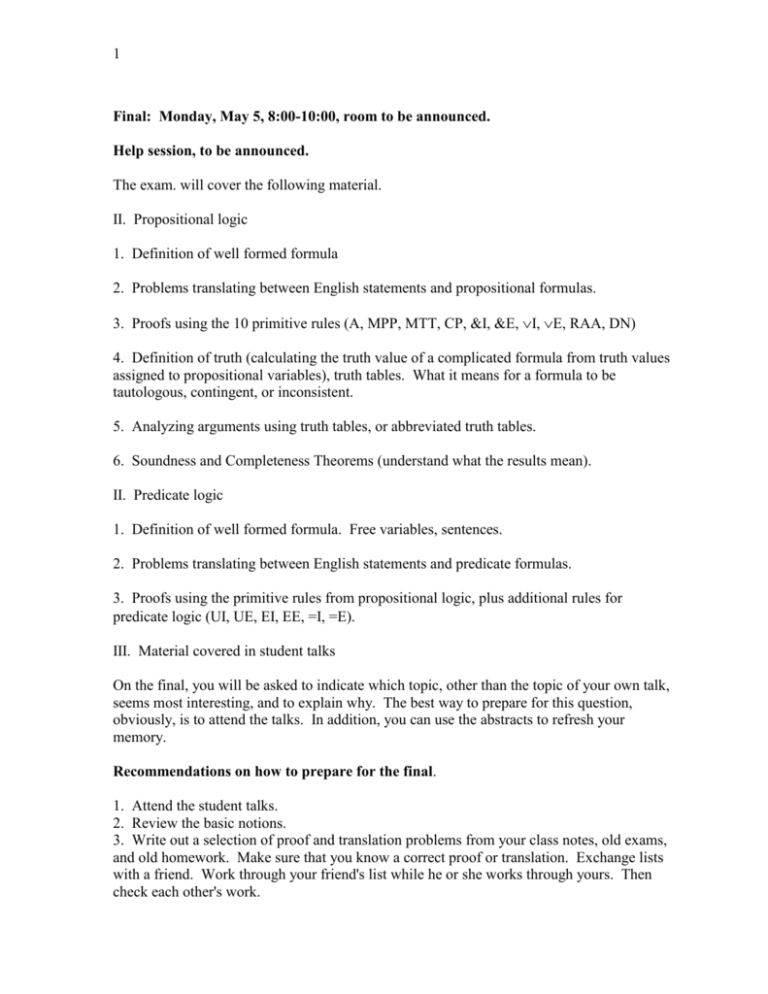
1 Final: Monday, May 5, 8:00-10:00, room to be announced. Help session, to be announced. The exam. will cover the following material. II. Propositional logic 1. Definition of well formed formula 2. Problems translating between English statements and propositional formulas. 3. Proofs using the 10 primitive rules (A, MPP, MTT, CP, &I, &E, I, E, RAA, DN) 4. Definition of truth (calculating the truth value of a complicated formula from truth values assigned to propositional variables), truth tables. What it means for a formula to be tautologous, contingent, or inconsistent. 5. Analyzing arguments using truth tables, or abbreviated truth tables. 6. Soundness and Completeness Theorems (understand what the results mean). II. Predicate logic 1. Definition of well formed formula. Free variables, sentences. 2. Problems translating between English statements and predicate formulas. 3. Proofs using the primitive rules from propositional logic, plus additional rules for predicate logic (UI, UE, I, E, =I, =E). III. Material covered in student talks On the final, you will be asked to indicate which topic, other than the topic of your own talk, seems most interesting, and to explain why. The best way to prepare for this question, obviously, is to attend the talks. In addition, you can use the abstracts to refresh your memory. Recommendations on how to prepare for the final. 1. Attend the student talks. 2. Review the basic notions. 3. Write out a selection of proof and translation problems from your class notes, old exams, and old homework. Make sure that you know a correct proof or translation. Exchange lists with a friend. Work through your friend's list while he or she works through yours. Then check each other's work. 2 4. Work through further miscellaneous problems. Note: Most people find it helpful to do at least some of their study in a group. 3 Some miscellaneous problems Propositional logic 1. Show (by giving a formation sequence) that (((P & ¬Q) R) ((R & ¬Q) ¬P)) is a wff of propositional logic. Determine whether it is tautologous, contingent, or inconsistent. 2. Prove the following (using only the 10 primitive rules of inference) (a) P, (P Q) |- (P & Q) (b) ¬P, (Q P) |- (¬P & ¬Q) (c) |- (P (P Q)) (d) (P Q), (Q R) |- (P R) (e) P, (R ¬P) |- ¬R (f) (R P), (R ¬P) |- ¬R (g) (P Q), (P R), (Q R) |- R (h)* |- (P ¬P) 3. Translate into propositional logic, indicating what your propositional variables stand for. (a) Classes are canceled if either it is snowing or the temperature is below 0. (If it is snowing, or if the temperature is below 0, then classes are canceled.) (b) It is Friday but the sun is not shining. (c) Tom embezzled money from ABAG, and if he is caught he will go to jail. 4. Translate the following argument into propositional logic. Then determine whether the argument is sound. Justify in terms of truth assignments. If the river floods, then our entire wheat crop will be destroyed. The river will flood if there is an early thaw. In any case, there will be heavy rains later in the summer. Therefore, if there is an early thaw, our entire community will be bankrupt unless there are heavy rains later in the summer. 5. Prove the following using only the 10 primitive rules (a)* ¬(P&Q) -||- (¬P ¬Q) (b)* ¬(PQ) -||- (¬P & ¬Q) (c)* ¬(PQ) -||- (P & ¬Q) Predicate logic 1. Show, by giving a formation sequence, that (y) (Rxy Gx) is a wff of predicate logic. 2. Which of the following are sentences ? For a formula which is not a sentence, give the free variables. (a) (x) (y) Fxy (b) (y) Lxy (c) (Gxa & Gya) 4 2. Translate the following argument into predicate logic, indicating what your predicate symbols stand for. Show that the argument is sound by giving a proof. Someone lost his or her book. Anyone who lost the book will be unable to read the chapter. Therefore, someone will be unable to read the chapter. 3. Letting P stand for the relation (among people) of parent (Pxy says that y is a parent of x), translate the following: (a) Everyone has a parent. (b) Not everyone is a parent. (c) No-one is the parent of everyone. (d) Everyone has exactly two parents. 4. Prove the following, using only the 16 primitive rules of inference. (a) (x) Fx, (x) (Fx Gx) |- (x) Gx (b) (x) (y) Gxy |- (x) Gxx (c) (x) (y) Rxy |- (y) (x) Rxy (d) ((x) Fx (x) Gx) |- (x) (Fx Gx) (e) (x) Fx |- (x) Fx (f) (x) Fx, (x) (Fx Gx) |- (x) Gx (g) (x) x = x (h) Fa, a = b, b = c |- Fc (i) |- (x) (y) ((Fx & x = y) Fy) (j)* |- (x) x = a 5. For each of the following, say whether it is a valid proof, and if not explain what is wrong. (a) 1 1. Em A 1 2. (x) Ex 1 UI (b) 1 1. (x) ¬x = c A 1 2. (x) (x) ¬x = x 1 UI (c) 1 1. (x) (Fx ¬c = x) A 1 2. (x) (x) (Fx ¬x = x) 1 EI 6. Give proofs, using just the primitive rules. (a)* ¬(x) Fx -||- (x) ¬Fx (b)* ¬(x) Fx -||- (x) ¬Fx (c)* Fa -||- (x) (x = a Fx)
